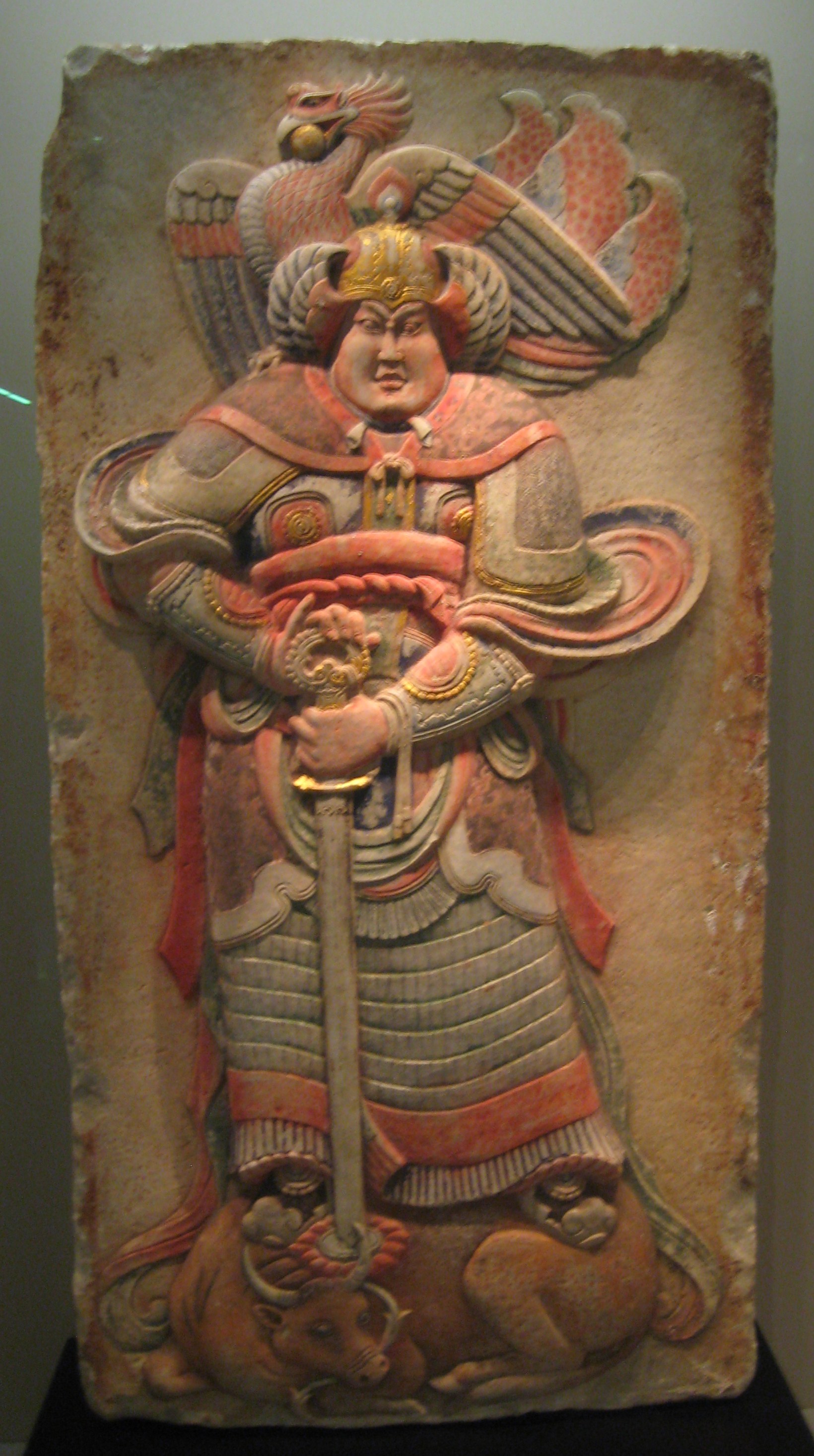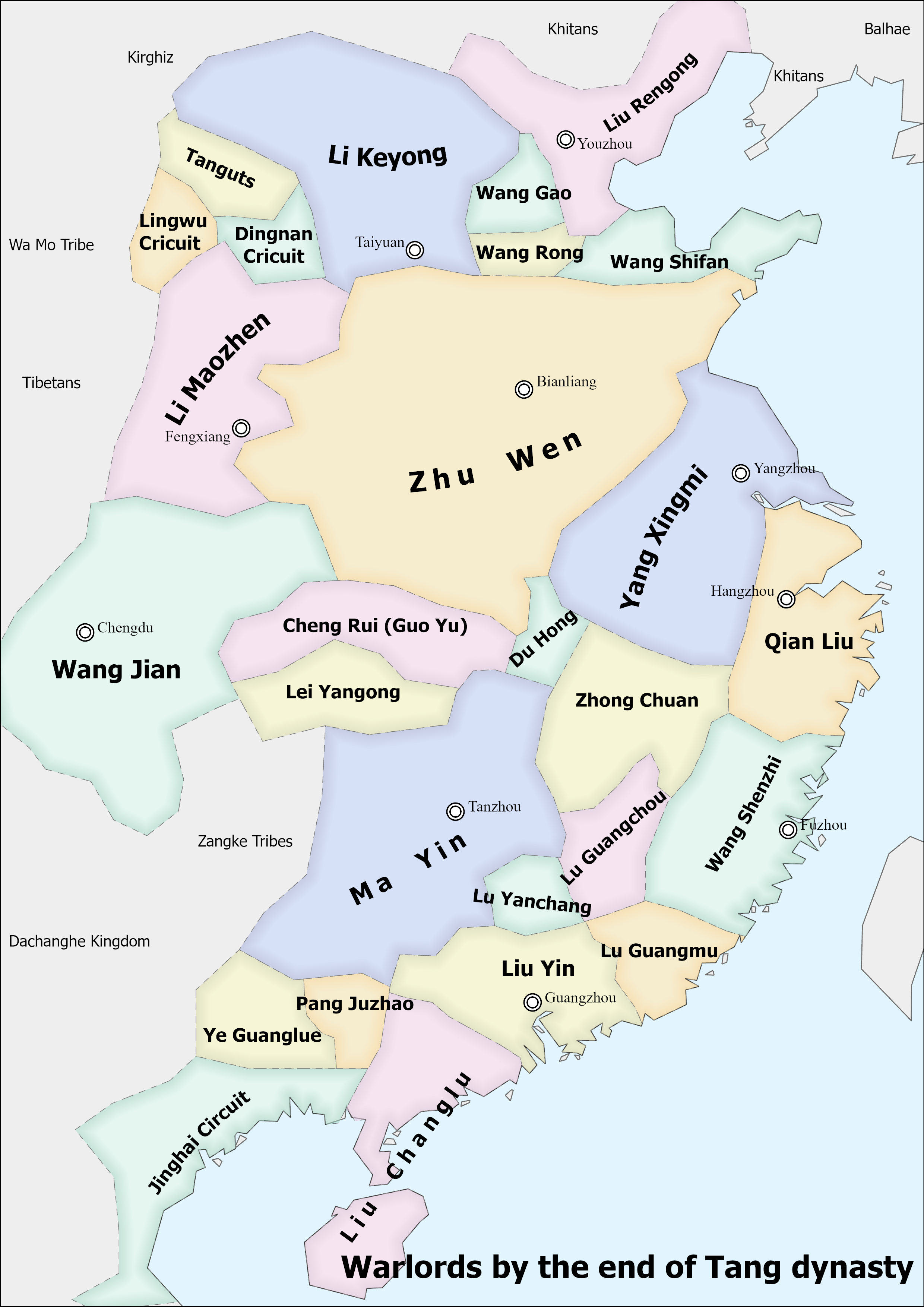|
Lu Yanchang
Lu Yanchang (盧延昌) (died 911) was a ruler of the Qian Prefecture (虔州, in modern Ganzhou, Jiangxi) region early in the Chinese Five Dynasties and Ten Kingdoms period. He inherited his position from his father Lu Guangchou, who had ruled the region for 25 years, but himself ruled only from 910 to 911 before being assassinated and succeeded by his officer Li Qiu. Background It is not known when or where Lu Yanchang was born, but it is known that his father Lu Guangchou was from Nankang (南康, in modern Ganzhou, Jiangxi). By 895, Lu Guangchou, who was then an agrarian rebel leader, had taken over Qian Prefecture and taken the title of prefect.''Zizhi Tongjian'', vol. 256. In 902, after Lu Guangchou conquered Shao Prefecture (韶州, in modern Shaoguan, Guangdong), he had Lu Yangchang govern it as prefect. When Lu Guangchou was subsequently repelled in his attack on Chao Prefecture (潮州, in modern Chaozhou, Guangdong) by Liu Yin the acting military governor of Qinghai ... [...More Info...] [...Related Items...] OR: [Wikipedia] [Google] [Baidu] |
Ganzhou
Ganzhou (), alternately romanized as Kanchow, is a prefecture-level city in the south of Jiangxi province, China, bordering Fujian to the east, Guangdong to the south, and Hunan to the west. Its administrative seat is at Zhanggong District. History Early settlement and administration In 201 CE, Emperor Gaozu of Han established a county in the territory of modern Ganzhou. In 236 CE, during the Three Kingdoms period, the was established in the area. In the early years, Han Chinese settlement and authority in the area was minimal and largely restricted to the Gan River basin. The river, a tributary of the Yangtze via Poyang Lake, provided a route of communication from the north as well as irrigation for rice farming. Sui dynasty In 589 CE, during the Sui dynasty, the was abolished, and the area was reorganized as Qianzhou. During the Song, immigration from the north bolstered the local population and drove local aboriginal tribes into admixing with the northerners. After t ... [...More Info...] [...Related Items...] OR: [Wikipedia] [Google] [Baidu] |
Later Liang (Five Dynasties)
Liang, known in historiography as the Later Liang () (1 June 907 – 19 November 923) or the Zhu Liang (), was an imperial dynasty of China and the first of the Five Dynasties during the Five Dynasties and Ten Kingdoms period. It was founded by Zhu Wen (Emperor Taizu), after he forced the last emperor of the Tang dynasty to abdicate in his favour (and then murdered him). The Later Liang would last until 923 when it was destroyed by the Later Tang dynasty. Formation Zhu Wen initially allied himself as Huang Chao's lieutenant. However, he took Huang's best troops and established his own power base as a warlord in Kaifeng. By 904, he had exerted control over both of the twin Tang dynasty capitals of Chang'an and Luoyang. Tang emperor Zhaozong was ordered murdered by Zhu in 904 and the last Tang emperor, Ai Di ( Emperor Ai of Tang), was deposed three years later. Emperor Ai of Tang was murdered in 908, also ordered by Zhu. Meanwhile, Zhu Wen declared himself emperor of ... [...More Info...] [...Related Items...] OR: [Wikipedia] [Google] [Baidu] |
Tang Dynasty Generals
Tang or TANG most often refers to: * Tang dynasty * Sour taste Tang or TANG may also refer to: Chinese states and dynasties * Jin (Chinese state) (11th century – 376 BC), a state during the Spring and Autumn period, called Tang (唐) before 8th century BC * Tang dynasty (唐; 618–907), a major Chinese dynasty * Later Tang (唐; 923–937), a state during the Five Dynasties and Ten Kingdoms period * Southern Tang (唐; 937–975), a state during the Five Dynasties and Ten Kingdoms period Food * Tang (drink mix), a brand name of instant fruit flavored drinks, produced by Mondelēz International * Guk (국), soup or stew in Korean cuisine, sometimes known as "tang" (탕; 湯) Places Europe * Tang, County Westmeath, a village in Ireland * Tang, North Yorkshire, a List of United Kingdom locations: Ta-Tha, settlement in England Asia * Tang, Ardabil, a village in Ardabil Province, Iran * Tang, Badakhshan, a village in Afghanistan * Tang, a village in Bumthang District, Bhutan * ... [...More Info...] [...Related Items...] OR: [Wikipedia] [Google] [Baidu] |
911 Deaths
__NOTOC__ 911 (Roman numerals, CMXI) was a common year starting on Tuesday of the Julian calendar. Events By place Europe * September 24 – King Louis the Child, Louis IV (the Child), the last Carolingian dynasty, Carolingian ruler of the East Francia, East Frankish Kingdom, dies at Frankfurt, Frankfurt am Main after an 11-year reign. The East Frankish dukes elect Conrad I of Germany, Conrad I at Forchheim as the king of the East Frankish Kingdom. Charles III is elected as king of Lotharingia. Conrad is chosen through the influence of Louis' guardian and regent, Hatto I (archbishop of Mainz), Hatto I, archbishop of Mainz. * Autumn – King Charles the Simple, Charles III (the Simple) and Rollo, leader of the Vikings, sign a peace agreement (Treaty of Saint-Clair-sur-Epte). In return for his homage and conversion to Christianity, Rollo becomes a vassal and is made Duke of Normandy, Count of Rouen; this is the beginning of the duchy of Normandy. He divides the lands ... [...More Info...] [...Related Items...] OR: [Wikipedia] [Google] [Baidu] |
9th-century Births
The 9th century was a period from 801 (represented by the Roman numerals DCCCI) through 900 (CM) in accordance with the Julian calendar. The Carolingian Renaissance and the Viking raids occurred within this period. In the Middle East, the House of Wisdom was founded in Abbasid Baghdad, attracting many scholars to the city. The field of algebra was founded by the Muslim polymath al-Khwarizmi. The most famous Islamic scholar Ahmad ibn Hanbal was tortured and Imprisonment, imprisoned by Abbasid official Ahmad ibn Abi Du'ad during the reign of Abbasid caliph al-Mu'tasim and caliph al-Wathiq. In Southeast Asia, the height of the Mataram Kingdom happened in this century, while Burma would see the establishment of the major kingdom of Pagan Kingdom, Pagan. Tang china, Tang China started the century with the effective rule under Emperor Xianzong of Tang, Emperor Xianzong and ended the century with the Huang Chao#Rebellions, Huang Chao rebellions. In America, the Maya civilization, Ma ... [...More Info...] [...Related Items...] OR: [Wikipedia] [Google] [Baidu] |
Nanchang
Nanchang is the capital of Jiangxi, China. Located in the north-central part of the province and in the hinterland of Poyang Lake Plain, it is bounded on the west by the Jiuling Mountains, and on the east by Poyang Lake. Because of its strategic location connecting the prosperous East China, East and South China, South China, it has become a major railway hub in Southern China in recent decades. As the Nanchang Uprising in 1927 is distinctively recognized by the ruling Chinese Communist Party, Communist Party as "firing the first gunshot against the Kuomintang, Nationalists", the current government has therefore named the city since 1949 "the place where the People's Liberation Army was born", and the most widely known "place where the military banner of the People's Liberation Army was first raised". Nanchang is also a major city, appearing among the top 100 List of cities by scientific output, cities in the world by scientific research outputs, as tracked by the Nature Inde ... [...More Info...] [...Related Items...] OR: [Wikipedia] [Google] [Baidu] |
Tang Dynasty
The Tang dynasty (, ; zh, c=唐朝), or the Tang Empire, was an Dynasties of China, imperial dynasty of China that ruled from 618 to 907, with an Wu Zhou, interregnum between 690 and 705. It was preceded by the Sui dynasty and followed by the Five Dynasties and Ten Kingdoms period. Historians generally regard the Tang as a high point in Chinese civilisation, and a Golden age (metaphor), golden age of cosmopolitan culture. Tang territory, acquired through the military campaigns of its early rulers, rivalled that of the Han dynasty. The House of Li, Li family founded the dynasty after taking advantage of a period of Sui decline and precipitating their final collapse, in turn inaugurating a period of progress and stability in the first half of the dynasty's rule. The dynasty was formally interrupted during 690–705 when Empress Wu Zetian seized the throne, proclaiming the Wu Zhou dynasty and becoming the only legitimate Chinese empress regnant. The An Lushan rebellion (755 ... [...More Info...] [...Related Items...] OR: [Wikipedia] [Google] [Baidu] |
Chu (Ten Kingdoms)
Chu (), known in historiography as Ma Chu () or Southern Chu (), was a dynastic state of China that existed from 907 to 951. It is counted as one of the Ten Kingdoms during the Five Dynasties and Ten Kingdoms period of Chinese history. Founding Ma Yin was named regional governor by the Tang court in 896 after fighting against a rebel named Yang Xingmi. He declared himself as the Prince of Chu with the fall of the Tang dynasty in 907. Ma's position as Prince of Chu was confirmed by the Later Tang in the north in 927 and was given the posthumous title of King Wumu of Chu. Territories The capital of the Chu Kingdom was Changsha ( Tanzhou). The kingdom ruled over present-day Hunan and northeastern Guangxi. Economy Chu was peaceful and prosperous under Ma Yin's rule, exporting horses, silk and tea. Silk and lead coinage were often used as currency, particularly with external communities which would not accept other coinage of the land. Taxation was low for the peasantry and mer ... [...More Info...] [...Related Items...] OR: [Wikipedia] [Google] [Baidu] |
Ma Yin
Ma Yin (; c. 853 – December 2, 930), courtesy name Batu (霸圖), also known by his posthumous name as the King Wumu of Chu (楚武穆王), was a Chinese military general and politician who became the founding ruler of the Chinese Ma Chu dynasty during the Five Dynasties and Ten Kingdoms period. He was the only monarch who carried the title of "king" in his dynasty.Ma Yin's title was ''Wang'' (王) in Chinese, which could be translated as either "Prince" or "King" in English. The translation of "Prince" will be used here during the time that he carried the title of ''Wang'' of Chu during Later Liang and most of Later Tang. The translation of "King" will be used after he was created the ''Guowang'' (literally, "State King/Prince") of Chu by Li Siyuan, a title that carried for the rest of his life. He initially took control of the Changsha region in 896 after the death of his predecessor Liu Jianfeng, and subsequently increased his territorial hold to roughly modern Hunan and n ... [...More Info...] [...Related Items...] OR: [Wikipedia] [Google] [Baidu] |
Yang Longyan
Yang Longyan () (897 – June 17, 920), né Yang Ying (), also known as Yang Wei (), courtesy name Hongyuan (), also known by his temple name as the Emperor Gaozu of Yang Wu (), was a monarch of the Yang Wu dynasty of China during the Five Dynasties and Ten Kingdoms period, reigning initially as the Commandery Prince of Hongnong and later as the Prince of Wu. Throughout his reign, the governance of the Yang Wu state was under the effective control of the regent Xu Wen. Background Yang Longyan was born in 897, during the reign of Emperor Zhaozong of Tang; he was the second son of Yang Xingmi, who, by the time of his birth, was a major warlord as the military governor (''Jiedushi'') of Huainan Circuit (淮南, headquartered in modern Yangzhou, Jiangsu). His mother was Yang Xingmi's concubine Lady Shi, who was also the mother of his older brother Yang Wo. (Yang Longyan's four younger brothers all appear to be born of different mothers; Yang Pu was known to be born of Lady ... [...More Info...] [...Related Items...] OR: [Wikipedia] [Google] [Baidu] |





